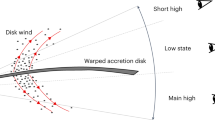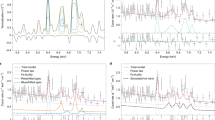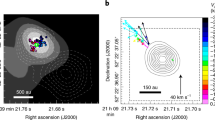Abstract
Invariably, black hole accretion disks seem to produce plasma outflows that result in blue-shifted absorption features in their spectra1. The X-ray absorption-line properties of these outflows are diverse, ranging in velocity from non-relativistic2 (~300 km s–1) to sub-relativistic3 (~0.1c, where c is the speed of light) and a similarly broad range in the ionization states of the wind plasma2,4. We report here that semi-analytical, self-similar magnetohydrodynamic wind models that have successfully accounted for the X-ray absorber properties of supermassive black holes5,6 also offer a good fit to the high-resolution X-ray spectrum of the accreting stellar-mass black hole GRO J1655–40. This provides an explicit theoretical argument of their magnetohydrodynamic origin (aligned with earlier observational claims)7 and supports the notion of a universal magnetic structure of the observed winds across all known black hole sizes.
This is a preview of subscription content, access via your institution
Access options
Access Nature and 54 other Nature Portfolio journals
Get Nature+, our best-value online-access subscription
$29.99 / 30 days
cancel any time
Subscribe to this journal
Receive 12 digital issues and online access to articles
$119.00 per year
only $9.92 per issue
Buy this article
- Purchase on Springer Link
- Instant access to full article PDF
Prices may be subject to local taxes which are calculated during checkout




Similar content being viewed by others
References
Crenshaw, D. M., Kraemer, S. B. & George, I. M. Mass loss from the nuclei of active galaxies Annu. Rev. Astron. Astrophys. 41, 117–167 (2003).
Behar, E. et al. A long look at NGC 3783 with the XMM-Newton reflection grating spectrometer. Astrophys. J. 598, 232–241 (2003).
Tombesi, F. et al. Evidence for ultra-fast outflows in radio-quiet AGNs. I. Detection and statistical incidence of Fe K-shell absorption lines. Astron. Astrophys. 521, 57–92 (2010).
Holczer, T., Behar, E. & Kaspi, S. Absorption measure distribution of the outflow in IRAS 13349+2438: direct observation of thermal instability? Astrophys. J. 663, 799–807 (2007).
Fukumura, K., Kazanas, D., Contopoulos, I. & Behar, E. Magnetohydrodynamic accretion disk winds as X-ray absorbers in active galactic nuclei. Astrophys. J. 715, 636–650 (2010).
Fukumura, K., Kazanas, D., Contopoulos, I. & Behar, E. Modeling high-velocity QSO absorbers with photoionized magnetohydrodynamic disk winds. Astrophys. J. Lett. 723, L228–L232 (2010).
Miller, J. M. et al. The magnetic nature of disk accretion onto black holes. Nature 441, 953–955 (2006).
Blandford, R. D. & Begelman, M. C. On the fate of gas accreting at a low rate on to a black hole. Mon. Not. R. Astron. Soc. 303, L1–L5 (1999).
Tombesi, F. et al. Wind from the black-hole accretion disk driving a molecular outflow in an active galaxy. Nature 519, 436–438 (2015).
Begelman, M. C., McKee, C. F. & Shields, G. A. Compton heated winds and coronae above accretion disks. I. Dynamics. Astrophys. J. 271, 70–88 (1983).
Murray, N. et al. Accretion disk winds from active galactic nuclei. Astrophys. J. 451, 498 (1995).
Blandford, R. D. & Payne, D. G. Hydromagnetic flows from accretion discs and the production of radio jets. Mon. Not. R. Astron. Soc 199, 883–903 (1982).
Contopoulos, J. & Lovelace, R. V. E. Magnetically driven jets and winds: exact solutions. Astrophys. J. 429, 139– 152 (1994).
Contopoulos, J. A simple type of magnetically driven jets: an astrophysical plasma gun. Astrophys. J. 450, 616–627 (1995).
Ferreira, J. Magnetically-driven jets from Keplerian accretion discs. Astron. Astrophys. 319, 340–359 (1997).
Neilsen, J. & Homan, J. A hybrid magnetically/thermally driven wind in the black hole GRO J1655–40? Astrophys. J. 750, 27–35 (2012).
Miller, J. M. et al. The accretion disk wind in the black hole GRO J1655–40. Astrophys. J. 680, 1359 (2008).
Kallman, T. R. et al. Spectrum synthesis modeling of the X-ray spectrum of GRO J1655–40 taken during the 2000 outburst. Astrophys. J. 701, 865–884 (2009).
Luketic, S., Proga, D., Kallman, T. R., Raymond, J. C. & Miller, J. M. On the properties of thermal disk winds in X-ray transient sources: a case study of GRO J1655–40. Astrophys. J. 719, 515–522 (2010).
Fukumura, K. et al. Magnetically driven accretion disk winds and ultra-fast outflows in PG 1211+143. Astrophys. J. 805, 17–27 (2015).
Kazanas, D., Fukumura, K., Behar, E., Contopoulos, I. & Shrader, C. Toward a unified AGN structure. Astron. Rev. 7, 92–123 (2012).
Shidatsu, M., Done, C. & Ueda, Y. An optically thick disk wind in GRO J1655–40? Astrophys. J. 823, 159–171 (2016).
Neilsen, J., Rahoui, F., Homan, J. & Buxton, M. A super-Eddington, Compton-thick wind in GRO J1655–40? Astrophys. J. 822, 20–34 (2016).
Netzer, H. A thermal wind model for the X-ray outflow in GRO J1655–40. Astrophys. J. Lett. 652, L117–L120 (2006).
Castor, J. I., Abbot, D. C. & Klein, R. I. Radiation-driven winds in Of stars. Astrophys. J. 195, 157–174 (1975).
Proga, D., Stone, J. M. & Kallman, T. R. Dynamics of line-driven disk winds in active galactic nuclei. Astrophys. J. 543, 686–696 (2000).
Behar, E. Density profiles in Seyfert outflows. Astrophys.J. 703, 1346–1351 (2009).
Miller, J. M. et al. Powerful, rotating disk winds from stellar-mass black holes. Astrophys.J. 814, 87–114 (2015).
Kallman, T. R & Bautista, M. A. Photoionzation and high density gas. Astrophys. J. Suppl. 133, 221–253 (2001).
Neilsen, J. & Lee, J. C. Accretion disk winds as the jet suppression mechanism in the microquasar GRS 1915+105. Nature 458, 481–484 (2009).
Hjellming, R. M. & Rupen, M. P. Episodic ejection of relativistic jets by the X-ray transient GRO J1655–40. Nature. 375, 464–468 (1995).
Dickey, J. M. & Lockman, F. J. H i in the Galaxy. Annu. Rev. Astron. Astr. 28, 215–261 (1990).
Blustin, A. J., Page, M. J., Fuerst, S. V., Branduardi-Raymont, G. & Ashton, C. E. The nature and origin of Seyfert warm absorbers. Astron. Astrophys. 431, 111–125 (2005).
George, I. M. et al. ASCA observations of Seyfert 1 galaxies. III. The evidence for absorption and emission due to photoionized gas. Astrophys. J. Suppl. 114, 73–120 (1998).
McKernan, B., Yaqoob, T. & Reynolds, C. S. A soft X-ray study of type I active galactic nuclei observed with Chandra high-energy transmission grating spectrometer. Mon. Not. R. Astron. Soc. 379, 1359–1372 (2007).
Laha, S. et al. Warm absorbers in X-rays (WAX), a comprehensive high-resolution grating spectral study of a sample of Seyfert galaxies. I. A global view and frequency of occurrence of warm absorbers. Mon. Not. R. Astron. Soc., 441, 2613–2643 (2014).
Chartas, G., Saez, C., Brandt, W. N., Giustini, M. & Garmire, G. P. Confirmation of and variable energy injection by a near-relativistic outflow in APM 08279+5255. Astrophys. J. 706, 644–656 (2009).
Schurch, N. J. & Done, C. The impact of accretion disc winds on the X-ray spectrum of AGN. I. XSCORT. Mon. Not. R. Astron. Soc. 381, 1413–1425 (2007).
Sim, S. A., Long, K. S., Miller, L. & Turner, T. J. Multidimensional modelling of X-ray spectra for AGN accretion disc outflows. Mon. Not. R. Astron. Soc. 388, 611–624 (2008).
Mihalas, D. Stellar Atmospheres (Freeman, 1978).
Crenshaw, D. M. & Kraemer, S. B. Feedback from mass outflows in nearby active galactic nuclei. I. Ultraviolet and X-ray absorbers. Astrophys. J. 753, 75–85 (2012).
King, A. L. et al. Regulation of black hole winds and jets across the mass scale. Astrophys. J. 762, 103–121 (2013).
Chakravorty, S. et al. Absorption lines from magnetically driven winds in X-ray binaries. Astron. Astrophys. 589, A119–A135 (2016).
Acknowledgements
We thank T. Kallman for providing us with the Chandra/HETG data for GRO J1655–40. K.F., D.K. and C.S. acknowledge support by a NASA/ADP grant. E.B. received funding from the European Unions Horizon 2020 research and innovation programm under the Marie Sklodowska-Curie grant agreement no. 655324. and from the I-CORE program of the Planning and Budgeting Committee (grant number 1937/12). Support for this work was in part provided by NASA through Chandra Award Number AR6-17013A issued by the Chandra X-ray Observatory Center, which is operated by the Smithsonian Astrophysical Observatory for and on behalf of NASA under contract NAS8-03060.
Author information
Authors and Affiliations
Contributions
K.F. led the overall model development and data fitting procedures. D.K., C.S, E.B. and F.T. each contributed to the validation, interpretation and presentation of the final results. The baseline wind model was originally formulated by I.C. In particular, D.K. provided insights connecting our results to the broader picture of accretion-induced outflows in astrophysical environments and E.B. provided technical advice on the details of atomic physics crucial to the X-ray spectroscopic analyses in this work. All authors contributed to writing the manuscript and preparing the figures and tables.
Corresponding author
Ethics declarations
Competing interests
The authors declare no competing financial interests.
Supplementary information
Supplementary Information
Supplementary Figures 1–4 and Supplementary Tables 1–2. (PDF 541 kb)
Rights and permissions
About this article
Cite this article
Fukumura, K., Kazanas, D., Shrader, C. et al. Magnetic origin of black hole winds across the mass scale. Nat Astron 1, 0062 (2017). https://doi.org/10.1038/s41550-017-0062
Received:
Accepted:
Published:
DOI: https://doi.org/10.1038/s41550-017-0062
This article is cited by
-
Ionized outflows from active galactic nuclei as the essential elements of feedback
Nature Astronomy (2020)
-
Accretion physics: It's not U, it's B
Nature Astronomy (2017)
-
Gone with the wind
Nature Physics (2017)



